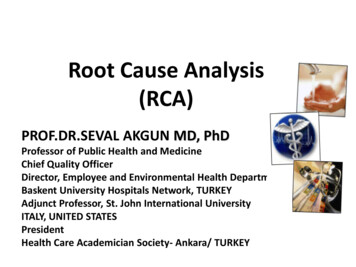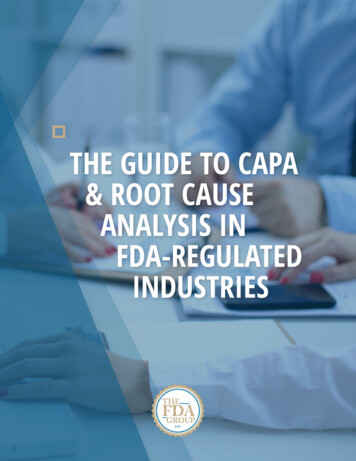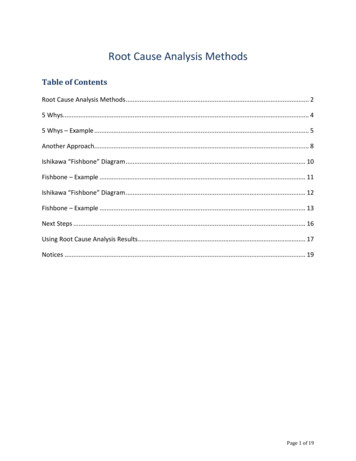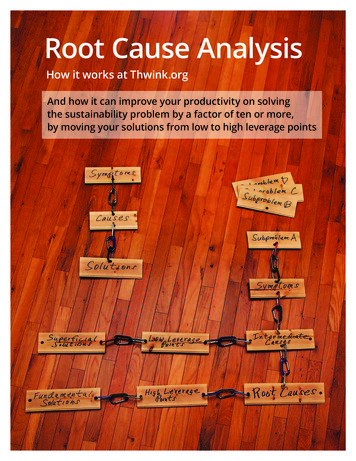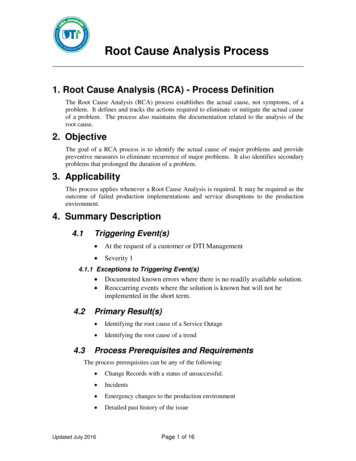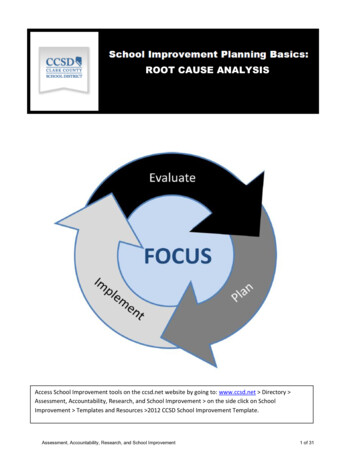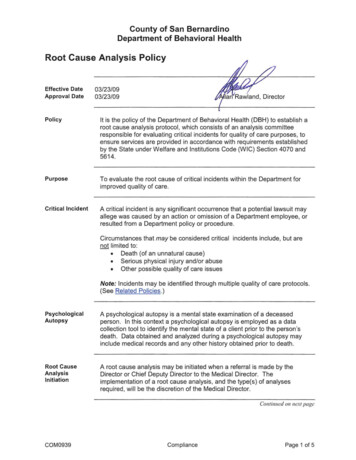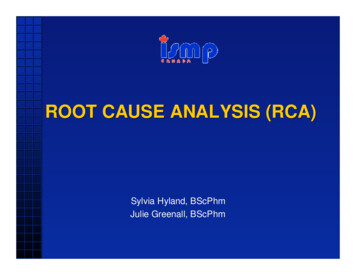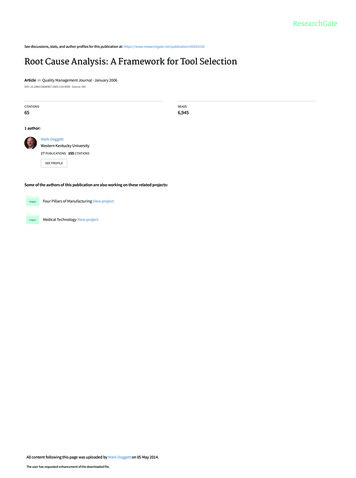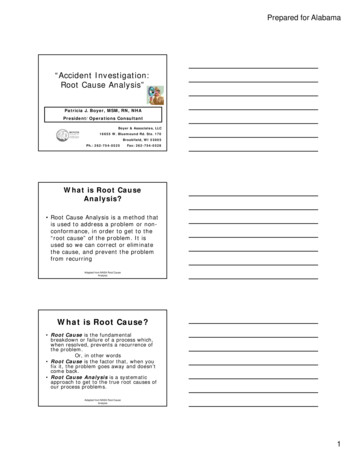
Transcription
Prepared for Alabama“Accident Investigation:Root Cause Analysis”Patricia J. Boyer, MSM, RN, NHAPresident/Operations ConsultantBoyer & Associates, LLC16655 W. Bluemound Rd. Ste. 170Brookfield, WI 53005Ph.: 262-754-0525Fax: 262-754-0528What is Root CauseAnalysis? Root Cause Analysis is a method thatis used to address a problem or nonconformance in order to get to theconformance,“root cause” of the problem. It isused so we can correct or eliminatethe cause, and prevent the problemfrom recurringAdapted from NASA Root CauseAnalysisWhat is Root Cause? Root Cause is the fundamentalbreakdown or failure of a process which,when resolved, prevents a recurrence ofthe problem.Or,, in other words Root Cause is the factor that, when youfix it, the problem goes away and doesn’tcome back. Root Cause Analysis is a systematicapproach to get to the true root causes ofour process problems.Adapted from NASA Root CauseAnalysis1
Prepared for AlabamaPhilosophy of Root CauseAnalysis Each problem is an opportunity because itcan tell a story about why and how itoccurred. It is critical that everyone take a personaland active role in improving quality. The “true” problem must be understoodbefore action is taken. To do this well, you must be– Both focused and open-minded– Both patient and quickAdapted from NASA Root CauseAnalysisSymptom Approach vsRoot Cause Symptom Approach Root Cause– Errors are a– Errors are aresult of workerresult of processcarelessnessfailure. Peopleare only part of– Trainingg toththe processmotivate people– Find out why itto be morehappened &carefulimplement– Don’t get to theprocesses so itbottom of thewon’t happenproblemagain– Fix it for goodAdapted from NASA Root CauseAnalysisHow do we do Root CauseAnalysis? Ask the Why–Why did the problem occur?–They ask why that happeneduntiltil you reachh theth processelement that failed.Adapted from NASA Root CauseAnalysis2
Prepared for AlabamaTypes of Tools Used in RootCause Analysis Brainstorming Fishbone Diagram Flowchart3
Prepared for AlabamaApplying the NursingProcess-The biggest“clue”clue of successNursing ntMonitor and ModifyIdentifyImplementEvaluateAudit & MonitorReinforce OptimalPerformanceImplement NecessaryChangesRecognition ofRisk FactorsIdentify theCauseDevelop Action PlanMeasuring/Evaluationof Facility Standards ofClinical Practice4
Prepared for AlabamaEvidence Based What is “Evidence-Based Practice”The use of current best evidence inmaking decisions about the care ofindividual residents. What is “Evidence-Based FacilityPractice”The integration of the clinician’sexpertise with values, residentpreferences and available evidence.Sackett, Gray, Haynes & Richardson, 1996Standardized Approach Use an organized approach Emphasize the basic process:prevention,tiassessment,tdocumentation and treatment“One of the testsof leadershipis the ability to recognizea problembefore it becomesan emergency.”Arnold Glasgow5
Prepared for AlabamaStatus ReviewsReview Systems: Flow chart/graph/data collectprocesses Review and tweakpolicy/procedures as you go-notas overwhelming Review compliance with practicestandards Audit-at minimum 10% monthlyStrategies for FacilityImprovement: EvaluateRisk Factors Target Resident and interviewFamily interviewsResident Satisfaction SurveysStaff Satisfaction SurveysInterview Staff ssion, Quarterly, SignificantChange minimally include: Fall Risk Smoking ability ElopementElt riski k Pain assessment Behavioral assessment Skin assessment Bowel, bladder assessment Quality of Life- Restorative6
Prepared for AlabamaFacility Action StepsDevelop a plan Seek guidanceRegulatory language–Regulatory–Medical Director and Physicians–Employees–Peers–Professional organizations–ConsultantsFacility Action StepsImplementation Set goal date Develop an Action plan Monitor progress frequently Educate staff Implement the planFacility Action StepsEvaluate Has the goal been met? Are there any adjustmentsneeded?–Seek input from residents,family and staff Make adjustments and/orredefine the plan7
Prepared for AlabamaFacility Action StepsMonitor Set up a routine timeframe Assign responsibilities Enforce accountability Re-evaluate systems regularly“If you don’t knowwhere you are going, youwill probably end upsomeplace else.”Someplace ElsePop. 215Yogi BerraAccidents Incidents8
Prepared for AlabamaRegulatory LanguageAccidents and Supervision F323The facility must ensure that:–The resident environmentremainsias freefoff accidentid thazards as is possible; and–Each resident receivesadequate supervision andassistance devices to preventavoidable accidents.Methods to Meet Intent Identifying hazards and risks; Evaluating and analyzing hazardsandd risks;i k Implementing interventions toreduce hazards and risks; and Monitoring for effectiveness andmodifying interventions asindicated.Overview: Commitmentto SafetyA facility with a commitment tosafety:–Identifies risk–ReportsRt riski k–Involves all staff–Utilizes resources–Commitment to safetydemonstrated at all levels oforganization9
Prepared for AlabamaA Systems ApproachIdentification of Hazards andRisksSources for identifying hazardsmay include:Quality assurance activities–Environmental rounds–MDS/RAPS data–Medical history and physicalexam–Individual observationA Systems ApproachEvaluation and Analysis The facility examines datagathered through identificationof hazards and risks and appliesit to the development ofinterventions to reduce thepotential for accidents. Interdisciplinary involvement is acritical component of thisprocess.A Systems ApproachImplementation ofInterventions Communicating the interventionsto all relevant staff Assigning responsibilityesponsibilit Providing training as needed Implementing and documentinginterventions Ensuring that interventions areimplemented10
Prepared for AlabamaSystems Approach ofMonitoring and Modification Ensuring that interventions areimplemented correctly andconsistently EvaluatingE litheh effectivenessffioffinterventions Modifying or replacinginterventions as needed Evaluating the effectiveness ofnew interventionsResident to ResidentAltercationsSituations that may increase thepotential for resident to residentaltercations include: History of aggressive behavior Negative interactions with otherresidents Disruptive or annoying behavior History of inappropriate behaviorSupervision Resident-toResident Altercations Facilities need to take reasonableprecautions to prevent resident-toresident altercations. CCertaint i situationsit tior conditionsditimayincrease potential for resident-toresident altercations:– History of aggressive behavior– Negative interactions with anotherresident– Disruptive or annoying behavior3311
Prepared for AlabamaDefinition:Supervision/AdequateSupervision “Supervision/Adequate Supervision”refers to an intervention and means ofmitigating the risk of an accident. Adequate supervision is defined by thetype and frequency of supervision,based on the individual resident’sassessed needs and identified hazardsin the resident environment.Prevention of Falls TeamworkSystems ApproachPatient specific causesSeating and PositioningFalls and Medications12
Prepared for AlabamaCost of Falls 5.3% of hospital admissions ofindividuals over 65 are due tofalls Mean LOS 8-158 15 days 42% of fallers reduce activityafter falling 40-73% of fallers have “fear offalling”Good News Falls can be successfullymanaged Must develop a passionate focus Understand and use your QIQI’ss–QI’s provide a “Sneak Peek atthe Test before the surveyorsget there” Trend your falls Develop comprehensive teamapproachBad News - If they’re notwell managed Facility–Fines–Loss of reputation–Loss of revenue–Increased cost of care–Potential for lawsuits Patient– Fear of ambulating, fallingagain13
Prepared for AlabamaResponse to Falls Immediate response–Assess patient–Identify cause of fall–Medical care for resident–Establish temporary “keepsafe” plan–Document intervention–Complete incident reportHow to do it well Ideal Outcome–Maintain the health of thepatient–MaintainM i t i theth healthh lth off thethfacility’s systemsOverview: Commitmentto SafetyA facility with a commitment tosafety:–Identifies risk–Reports risk–Involves all staff–Utilizes resources–Commitment to safetydemonstrated at all levels oforganization14
Prepared for AlabamaSystemsConsistent Team ApproachVigilanceLeadershipSystems ReviewTrendingQIsAccountabilityCommitted PhysiciansNoCitationsAssessment SystemImmediate InterventionGood DocumentationInterventions - POCSystems that work Teams A team is only as good as its weakestlink The keys to creating an effective teamare:– Mutual respect– Communication– Focus and passion towardprevention– A genuine concern for the safety ofall residents.15
Prepared for AlabamaTeams Administrator’s role:–Sets the expectations–Sets Environmental standards–EstablishesEstablishes accountability–Responsible for RegulatoryCompliance and quality of lifefor the residents–Financing - Equipment,Maintenance, Staff–Facilitates consistent CQITeams DON - Coordinates team’s efforts– Establishes standards andaccountability– Establishes system for FallsMManagementt– Trends incidents and establishespatterns– Coordinates team efforts to assesssystem failures resulting inidentified trends– Holds staff accountableTeams Unit Manager clinical case manager– Understands all aspects of theindividual patient’s needs, habitsand deficits– Identifies patient specific risks andcontributing factors– Is responsible for the quality of herunit’s focus on falls prevention– Monitors potential Medical andPolypharmacy risks for her patients16
Prepared for AlabamaTeams Managing Physician– Often not included Due to lack of time, respect, orresponsiveness Nursing tries to solve all problemsin-house without involving the MD– Must have comprehensiveunderstanding of Geriatric Medicine– Must strongly support interventionto prevent functional loss andmaintain quality of life for theresidentTeams Medical Director–Responsible for the quality ofMedical Care available in thebuilding–Intervenes as an advocate forthe facility when managingphysicians need mentoring–Takes an aggressive approachto Quality AssuranceTeams Medical Director– Reviews incidents and accidenttrends– Assists the DON in identifyingsystemsyse widede oor papatientespecspecificccauses– Assists in modification of policiesand procedures resulting from QAprocess– Communicates with and holdsmanaging physicians accountablefor following facility policies17
Prepared for AlabamaTeams Physical Therapist– Triages patients into appropriateactivity or restorative programsthrough quarterly screens andevaluations as needed– Assists the team to identify systemwide and patient specific causes forfalls– Evaluates specific patients forbalance, coordination, strength andperceptual deficits– Provides rehab treatment asappropriateTeams Occupational Therapist– Assists the team to identify systemwide and patient specific causes forfalls– Evaluates specific patients for safetyjudgment, problem solving andperceptual skill deficits as theypertain to late loss ADLs– Evaluates and modifies seating andpositioning systems to meet needs ofpatients– Provides rehab treatment asappropriateTeams Speech and Language Pathologists– Assists the team to identify systemwide and patient specific causes forfalls– Evaluates specific patients for safetyjudgment, problem solving, cognitiveand communication deficits as theypertain to falls– Consults and provides remedialequipment for audiological needs ofthe patient– Provides rehab treatment asappropriate18
Prepared for AlabamaTeams Activity Directors and Staff– Assists the team to identify systemwide and patient specific causes forfalls– Assists with assessment of social,emotional and physical deficits asthey relate to falls– Assists the resident to maintainfeeling of self worth throughappropriate activities– Are key to assisting the resident tomaintain their optimal level ofphysical fitnessTeams Nursing Assistants– Assists the team to identify systemwide and patient specific causes forfalls– Are keyy to accurate informationregarding environmental,behavioral and physical risks to thesafety of residents– Ensure safety of the residentthrough vigilance, common senseand a strong commitment to thewell being of the residentTeams Maintenance and Housekeeping– Assists the team to identify systemwide and patient specific causes forfalls– Are key to the environmental safetyof the residents– Provide prompt repair of brakes onbeds, wheelchairs and otherequipment used by patient– Prevent clutter and otherenvironmental hazards that imperilsafety of staff/residents19
Prepared for AlabamaAccountability Accountability–Without accountability, allplans and interventions areuseless–Each team member mustunderstand what they areaccountable to do–Each manager must hold eachteam member accountable forresults, not just processTeam review Next morning stand-up meetingreview Review contributing factors PlanPlshouldh ld addressddeachh factorf t Modify intervention if needed Document changes inPOC/nurses notes Refer to PT, OT, ST if appropriateTeam Review Each week - Falls Committee– All falls are reviewed in-depth Causes Interventions Effectiveness Modifications if needed– All modifications are recorded onthe POC– Minutes of the meeting are kept20
Prepared for AlabamaTeam Review Each month Quality AssuranceCommittee–Trends are examined to identifyany patterns–Systems are reviewed forpotential modification–Individual patient issues arereviewed if unresolvedTrends help identifycause If most falls occur during changeof shift If most falls occur between 5pmand 7pm If most falls occur on oneparticular unit during themidnight shift and only whennurse Jane is working If most falls occur during thefirst 48 hours of admissionAnalyzing InformationGarbage inequalsgarbage out21
Prepared for AlabamaOutcomes Analysis Requires accurate data collection,analysis and trending Analysis of trends results inyfailuresidentification of system An acceptable standard must beidentified Outcomes compared to that standard Progress toward team goals needs tobe communicated to entire team (NAstoo!)Prevention Predict greatest risk– Shifts– Units– New or lower quality staff Dedication of staff– Attitude shift - “It’s a job” to “I’m fond ofmy residents”– Stabilize staffing pattern - Know habits ofresidentsPrevention - Staffing Staffing Pattern– Match staffing pattern to identified trends Volunteer role Family member’s role Dual Hats - Multiple roles of all staff– Sundowner’s hours– Group patients to allow lower ratiostaff:patient22
Prepared for AlabamaDON or Unit Manager Notify physician Notify family Review incident report anddocumentation Follow-up intervention plan– Is equipment in place?– Have Nurses aides been informed?– Is staff implementing plan?– Is plan working?Follow up by Therapy Equipment reviewed– If equipment must be ordered,Therapy must also implement atemporarytepo a y keepeep safesa e planpaequipment arrives– Therapy must document “keep safeplan”, and equipment that has beenordered, expected arrival date– Therapy to track equipment orderand document in medical chartPhysical Fitness Inactivity – Loss of balance– Loss ofendurance– Loss of posturalreflexes– Loss of strength– Loss of speed ofreaction– Loss ofcoordination– Loss ofconfidence23
Prepared for AlabamaPhysical Fitness Strong Activity program– Triage all patients into activitycategories– Walking for distance (walkie talkie) Walk across America or your state– Walk to dine, walk to toilet, walk toshower– Transfer to dining room chairs (sixadditional sit to standopportunities to strengthenmuscles)Success Decrease in incidence of falls Improvement in resident safety Decreased risk of citations Improved customer satisfactionWashington State Dept ofHealth Root Cause Analysis The Adverse Event OccursYour Policy Explains: How to report an event How to care for the patientq por articles How to secure equipment How to secure original documents When to obtain photos Responsibility for Disclosure & Notifications—Attending MD’s, Client/Patient, Internal & ExternalNotifications How to conduct staff discussions24
Prepared for AlabamaRoot Cause Analysis Root Cause Analysis–––––Step 1 Identify the Adverse EventStep 2 Identify the RCA TeamStep 3 Conduct the RCAStep 4 Develop an Action PlanStep 5 Measure the Effectiveness ofPlan– Step 6 Communicate the FindingsRoot Cause Analysis Step 1 Identify the Adverse Event– Receive the Adverse Event Report– Triage the Adverse Event Using Experts VA National Center for PatientSafety—SafetySaety Sa ety Assessmentssess e t Code Joint Commission Sentinel Events American Medical Director Association(AMDA) Determine Events Not Eligible forRCA’s– Receive Organizational EndorsementRoot Cause Analysis Step 2 Identify the RCA Team– Identify Content Experts—Those mostfamiliar with situation– siciansPharmacy, Operations– This is an opportunity to teach staffhow to utilize an RCA methodology25
Prepared for AlabamaRoot Cause Analysis Step 3 Conduct the RCA– Short Inservice on Conducting RCA’s(15 minutes)– EstablishE t bli h CConfidentialityfid ti lit– Ground Rules for Team Management– Assign TasksRoot Cause Analysis Step 3 Conduct the RCA– Meeting 1: Present the Event, Flow Chartor Time Sequence the Events Known,Assign Tasks to Members– Meeting 2: Review Findings from Tasks,Edit the Flow Chart or Time Sequence,Identify Causal Statements, and Developan Action Plan– Meeting 3: Establish EffectivenessMeasures and Communication PlanRoot Cause Analysis Step 4 Develop an Action Plan– Literature Review– Review Findings From: Policy & Procedures,Interviews, Site Visits, EquipmentInvestigations,Investigations– Determine Contributing Factors and RootCauses– Formulate Causal Statements– Identify System Changes with PreventionPlan– Assign Responsibilities26
Prepared for AlabamaRoot Cause Analysis Step 5 Measure the Effectiveness of Plan– How will you know success when yousee it?– Develop strategy for culture change– Strategy must impact the root cause– Education, policy & procedure changesleast effective– Plan concurrent reviews to determineeffectivenessRoot Cause Analysis Step 6 Communicate the Findings––––Plan For Staff FeedbackPatient Safety WalkroundsNewslettersDevelop a “Press Release”Compliance Rounds Routine environmental rounds–Water Temps, call-lights, roommanagement, infection control,bed device management etc.etc Preventative Maintenance Proper drug storage–Medication Pass–Medication Rooms27
Prepared for AlabamaGuardian Angel ProgramUse of Clinical Round Auditors: Advocacy for facility resident (s) Regularly randomized reviews Selection of a cross spectrum ofkey staff from all disciplines Documented process for QA/QI Performance Improvementthrough all staff trainedOther Resources28
Prepared for AlabamaAdvancing ExcellenceHow to get involved: Facilities are encouraged to jointhe campaign and can sign up forat:www.nhqualitycampaign.org Quality Materials are available onthe Web: www.MedQIC.orgAdvancing Excellence State QIOs also can provide facilitysupport. All QIOs names, addressesand other contract information arelisted on the MedQIC Web site. CMS access to data is through NursingHome Compare as previouslyavailable along with aggregate dataresults posted to the campaign on aquarterly basis.Advancing ExcellenceCampaign Eight Goals: Reduce Pressure UlcersReduce Restraint UseImprove Pain ManagementSet STAR TargetsConduct Satisfaction SurveysImprove Retention of StaffIncrease/use ConsistentAssignments29
Prepared for AlabamaBest Practice ExamplesThat ARE Practical: AT Risk Clinical Meeting Photographic Evidence Monitoring of Hazards throughCompliance Rounds Use of Refusal of Treatment Abuse Prevention Focus on Resident Auditing Documents Always BE READY Build and Maintain The BEST TEAMPatient At RISK (PAR)Clinical Meetings“Best Practice”Interdisciplinary team meeting onceper week to identify at-risk residents:WHO: NHA, DON, RD, Rehab, Pharmacy, Medical Director,Social Worker,Worker Activity Director,Director HospiceWhat: At risk issues that have occurred over the course ofpast week:falls, investigations, new behaviors, new open areas,weight changes, restraint/devices in use, and end of lifechanges etc.Why: Communication of events, interventions put in place,evaluation of significant change of condition, and care planchanges made.What measures will be put into placeor systemic changes made to ensurethat the deficient practice will notoccur. Random audits will be completed weekly bythe unit manager to ensure that .Anyconcerns identified will have immediatecorrective action and will be forwarded toth DON andthed CQI/PI CCommitteeittffor ffurtherthresolution. The policy and procedure has been revisedto ensure that The DON or designee will review 10% of therecords weekly. Any issues identified willhave immediate follow up for correctiveaction. All results will be forwarded to theCQI/PI Committee.30
Prepared for AlabamaA Systems ApproachMonitor and ModifyIdentifyImplementEvaluateLastly Create a CultureDemonstrating The “Home”We’d All Want to Live andWork In Focus on effective systems Teamwork to accomplish the mutualgoals Create a culture of high qualityperformance Make the facility the type of homeyour residents want to live in.31
What is Root Cause Analysis? Root Cause Analysis is a method that is used to address a problem or non-conformance in order to get to the Adapted from NASA Root Cause Analysis conformance, in order to get to the "root cause" of the problem. It is used so we can correct or eliminate the cause, and prevent the problem from recurring

